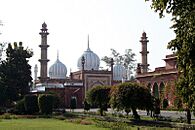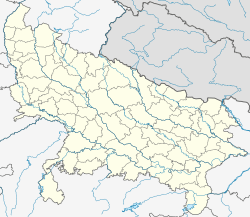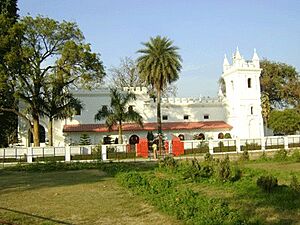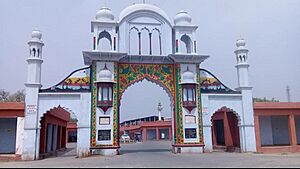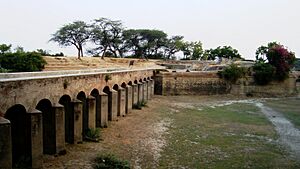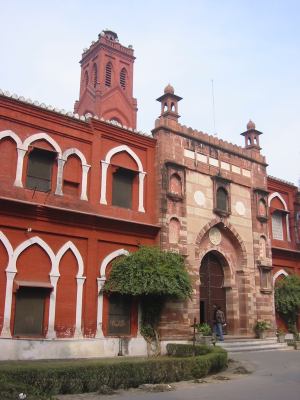Aligarh facts for kids
Quick facts for kids
Aligarh
|
|
|---|---|
|
City
|
|
|
From top, left to right: Sir Syed Mosque; Aligarh Clock Tower; Bab-e-Syed, Church of Ascension; Aligarh Habitat Centre; Kennedy House Complex
|
|
| Country | |
| State | |
| Division | Aligarh |
| District | Aligarh |
| Government | |
| • Type | Municipal Corporation |
| • Body | Aligarh Municipal Corporation |
| Elevation | 178 m (584 ft) |
| Population
(2011)
|
|
| • Total | 874,408 |
| • Rank | 53 |
| Demonym(s) | Aligarian |
| Language | |
| • Official | Hindi |
| • Additional official | Urdu |
| • Regional | Braj Bhasha |
| Time zone | UTC+5:30 (IST) |
| PIN Code |
202001, 202002
|
| Telephone code | 0571 |
| Vehicle registration | UP-81 |
Aligarh () is a big city in the state of Uttar Pradesh in India. It was once known as Koil. Aligarh is the main city of the Aligarh district. It is about 342 kilometers (213 miles) northwest of Lucknow, the state capital. It is also about 130 kilometers (81 miles) southeast of New Delhi, India's capital.
Many cities and districts are close to Aligarh. These include Gautam Buddha Nagar, Bulandshahr, and Mathura. In 2011, Aligarh was the 53rd most populated city in India.
The city's history goes back to the 12th century, when it was called Kol. Kol was a very important city during the Delhi Sultanate and Mughal Empire. It was a center for both politics and business. The city's name changed several times. It became Aligarh in the mid-1700s. Aligarh is well-known for Aligarh Muslim University. This famous university started as Muhammadan Anglo-Oriental College in 1875.
Contents
- History of Aligarh: From Kol to Today
- How Aligarh is Governed
- People and Languages in Aligarh
- Geography and Climate of Aligarh
- Economy and Industries in Aligarh
- Education in Aligarh
- Art and Craft in Aligarh
- Places to Visit in Aligarh
- Getting Around Aligarh
- Famous People from Aligarh
- See also
- Images for kids
History of Aligarh: From Kol to Today
Written records about Aligarh start in the 12th century. However, old findings show that Jains lived there even earlier. Before the Ghurid people took over, the area was ruled by Dor Rajputs in the 12th century.
In 1194, Qutb-ud-din Aibak successfully took control of the region. Hisam-ud-din Ulbak became the first Muslim governor. A historian named Hasan Nizami called Kol "one of the most famous forts of Hind." From the 13th century, Kol (or Koil) was known as an important business place. It was especially famous for making distilled wine. By the mid-13th century, the city was so important that Ghiyas ud din Balban built a tall tower there.
Under the Khilji and Tughlaq rulers, Kol continued to be important. It became an iqta (a type of land grant) during the time of Alauddin Khalji.
The famous traveler Ibn Battuta mentioned Kol in his book Rihla. In 1341, he traveled through Kol with 15 ambassadors from the Mongol Chinese Yuan dynasty. They were on their way to the coast. Ibn Battuta said Kol was "a fine town surrounded by mango groves." These groves gave the area the name Sabzabad, meaning "the green country."
During the rule of Akbar, Kol became a Sirkar (a type of administrative division). Akbar and Jahangir visited Kol for hunting. Jahangir wrote about hunting wolves in the forests of Kol.
In the time of Ibrahim Lodhi, Muhammad, son of Umar, was the governor. He built a fort in Kol and named the city Muhammadgarh in 1524–25. Later, Sabit Khan, another governor, rebuilt the old fort. He named the town Sabitgarh after himself.
In 1753, the Bargujar King Bahadur Singh ruled Koil. He fought against the destruction of Hindu temples. The Jat ruler, Surajmal, took over the fort of Koil. Bahadur Singh continued fighting from another fort. He died in the "Battle of Ghasera." The fort was then renamed Ramgarh.
When a Persian Mughal commander, Najaf Khan, captured Ramgarh, he gave it its current name, Aligarh. The Aligarh Fort was built by French engineers.
The Battle of Aligarh (1803)
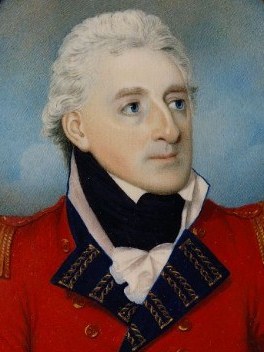
The Battle of Aligarh happened on September 1, 1803. It was part of the Second Anglo-Maratha War. The battle took place at Aligarh Fort. The British 76th Regiment attacked the fort. It was controlled by a French officer named Perron. The British won, and their rule began in the area. In 1804, the Aligarh district was created.
How Aligarh is Governed
Aligarh district is divided into five smaller areas called tehsils. These are Kol Tehsil, Khair Tehsil, Atrauli, Gabhana, and Iglas. These tehsils are then split into 12 blocks.
The city itself is managed by the Nagar Nigam Aligarh, which is like a city council. It handles daily city services. The Mayor and a Municipal Commissioner lead this body. The Aligarh Development Authority (ADA) works on building and improving the city's infrastructure.
Aligarh is also the main office for the Aligarh Police Range. A high-ranking police officer (DIG) oversees law and order in Aligarh. Another officer (Commissioner) is in charge of four districts in the Aligarh Division.
People and Languages in Aligarh
| Religions in Aligarh city (2011) | ||||
|---|---|---|---|---|
| Religion | Percent | |||
| Hinduism | 55.36% | |||
| Islam | 42.64% | |||
| Christianity | 0.53% | |||
| Other or not stated | 0.47% | |||
| Distribution of religions | ||||
According to the 2011 Census, Aligarh has a population of 874,408 people. There are more males (461,772) than females (412,636). About 119,543 children are aged 0–6 years. The city's literacy rate is 59.15%. This means that most people can read and write.
Hindi is the most common language spoken in Aligarh. Urdu is the second most common language.
Geography and Climate of Aligarh
Where is Aligarh Located?
Aligarh is located at 27.88° North latitude and 78.08° East longitude. It is about 178 meters (587 feet) above sea level. The city is in the middle of the doab. This is the land between the Ganges and Yamuna rivers. The Grand Trunk Road (NH-91) goes through Aligarh. It is 134 km (83 miles) from India's capital.
What is Aligarh's Climate Like?
Aligarh has a hot, semi-dry climate. Summers begin in April and are very hot. Temperatures are highest in May, usually between 28°C and 38°C (82°F and 100°F). The monsoon season starts in late June and lasts until early October. This brings a lot of humidity and most of the city's yearly rainfall.
Temperatures drop in December, and winter lasts until February. Winter temperatures are usually between 2°C and 11°C (36°F and 52°F). Winters are generally mild, but it can get very cold. The lowest temperature ever recorded was 0°C (32°F). Fog and cold snaps can be extreme.
| Climate data for Aligarh (1991–2020, extremes 1932–2011) | |||||||||||||
|---|---|---|---|---|---|---|---|---|---|---|---|---|---|
| Month | Jan | Feb | Mar | Apr | May | Jun | Jul | Aug | Sep | Oct | Nov | Dec | Year |
| Record high °C (°F) | 30.7 (87.3) |
33.3 (91.9) |
41.7 (107.1) |
44.8 (112.6) |
47.5 (117.5) |
46.7 (116.1) |
44.5 (112.1) |
42.1 (107.8) |
40.2 (104.4) |
41.7 (107.1) |
36.1 (97.0) |
32.8 (91.0) |
47.5 (117.5) |
| Mean daily maximum °C (°F) | 19.1 (66.4) |
23.5 (74.3) |
30.2 (86.4) |
37.1 (98.8) |
40.2 (104.4) |
38.6 (101.5) |
34.9 (94.8) |
33.2 (91.8) |
33.3 (91.9) |
32.8 (91.0) |
27.5 (81.5) |
22.0 (71.6) |
31.1 (88.0) |
| Mean daily minimum °C (°F) | 7.3 (45.1) |
10.4 (50.7) |
15.0 (59.0) |
20.5 (68.9) |
24.6 (76.3) |
26.5 (79.7) |
26.2 (79.2) |
25.5 (77.9) |
23.9 (75.0) |
19.2 (66.6) |
13.2 (55.8) |
8.6 (47.5) |
18.4 (65.1) |
| Record low °C (°F) | 0.0 (32.0) |
1.7 (35.1) |
3.9 (39.0) |
10.9 (51.6) |
15.5 (59.9) |
18.6 (65.5) |
19.9 (67.8) |
19.9 (67.8) |
14.8 (58.6) |
11.0 (51.8) |
2.9 (37.2) |
1.2 (34.2) |
0.0 (32.0) |
| Average rainfall mm (inches) | 15.2 (0.60) |
16.5 (0.65) |
10.4 (0.41) |
12.0 (0.47) |
27.2 (1.07) |
66.2 (2.61) |
217.7 (8.57) |
216.3 (8.52) |
107.7 (4.24) |
17.2 (0.68) |
2.7 (0.11) |
3.7 (0.15) |
712.8 (28.06) |
| Average rainy days | 1.4 | 1.4 | 1.3 | 1.0 | 2.7 | 4.0 | 9.3 | 10.3 | 5.5 | 1.0 | 0.3 | 0.4 | 38.6 |
| Average relative humidity (%) (at 17:30 IST) | 66 | 57 | 46 | 33 | 34 | 48 | 68 | 75 | 67 | 52 | 57 | 62 | 72 |
| Source: India Meteorological Department | |||||||||||||
Economy and Industries in Aligarh
Aligarh is an important center for trading farm products. Processing and making goods from these products are also big parts of its economy.
The city is very famous for its lock industry. Locks made in Aligarh are sent all over the world. The first English lock company, Johnson & Co., started here in 1870. They began making locks on a small scale in 1890.
Aligarh is also known for its brass items and sculptures. Many companies in the city make, sell, and export products made from brass, bronze, iron, and aluminum.
Other important industries include:
- Indian Diecasting Industries, which makes parts from aluminum and zinc.
- Harduaganj Thermal Power Station, a power plant 15 km (9 miles) away.
- Narora Atomic Power Station, a nuclear power plant 50 km (31 miles) from Aligarh.
- A Heinz-sauce factory.
- A cement factory owned by UltraTech Cement.
- Wave Distillery, which makes Kingfisher beer.
- A new Defense Corridor is also being built near Lodha.
Education in Aligarh
Aligarh is a major place for education. It has over 100 schools, colleges, and other learning centers. Some well-known institutions are:
- Aligarh College of Engineering and Technology
- Aligarh Muslim University
- Jamia Al Barkaat Aligarh
- Mangalayatan University
Art and Craft in Aligarh
Aligarh is known for a special art called phool patti ka kaam. This is a type of applique and embroidery work.
Places to Visit in Aligarh
Cultural Landmarks and Attractions
Aligarh has many interesting places to visit. Some of the most famous are:
- Aligarh Fort
- Jama Masjid (a mosque)
- Khereshwar Temple, which is the birthplace of Swami Shri Haridas Ji.
- The old Dor fortress (from 1524) is now in ruins. Its site is in the area called Upper Fort. An 18th-century mosque stands there now.
- The Shah Jamal area is famous for a Sufi saint named Syed Shah Jamal. His tomb is there, surrounded by a graveyard. The traveler Ibn Battuta mentioned this saint in his book.
The Annual Cultural Exhibition, known as Numaish, happens every January and February. It takes place at the exhibition ground. This land was given by Nawab Rehmat Ullah Khan Sherwani. During the Numaish, more than 150 stage shows happen. Artists from all over India perform for about 28–30 days.
Historical Sites in Aligarh
- Shekha Jheel, a bird sanctuary.
- Maulana Azad Library at AMU (started in 1875).
- Sir Syed Masjid on the Aligarh Muslim University campus.
Aligarh Muslim University (AMU)
Aligarh Muslim University (AMU) is one of India's oldest central universities. Sir Syed Ahmed Khan started it in 1875–78. It was first called Madrasatul Uloom Musalmanan-e-Hind. Later, it became Mohammedan Anglo-Oriental College (MAO College). The goal was to train Muslims for government jobs in India. It also prepared them for advanced studies in British universities. In 1920, MAO College became Aligarh Muslim University. It is well-known for its Law, Medical, and Engineering programs.
Museums in Aligarh
The Ibn Sina Academy of Medieval Medicine and Sciences has two museums. One is a 'Museum on History of Medicine and Sciences'. The other is a 'Museum on Arts, Culture and Orientalism'. These museums were started by the family of Hakim Syed Zillur Rahman and Syed Ziaur Rahman. They are located in the heart of the city, near the Dodhpur market.
Getting Around Aligarh
By Train
Aligarh Junction railway station is the main train station for Aligarh. It is a major stop on the route between Delhi and Kolkata. It is one of the oldest stations on this route. Trains from Aligarh connect to many states like West Bengal, Odisha, and Uttar Pradesh. It also connects to important cities like New Delhi railway station, Mumbai Central, and Kolkata.
Aligarh Junction handles over 136 trains every day. About 204,000 passengers use it daily. Aligarh also has a train line that goes to Bareily.
Other train stations in Aligarh City include:
- Somna (Gabhana) railway station
- Mahrawal railway station
- Kalua railway station
- Daudkhan railway station
- Mandrak railway station
- Harduaganj railway station (near Kasimpur Power House)
- Manjoorgarhi railway station (Chherat)
By Road
Aligarh is 140 km (87 miles) from New Delhi. The Uttar Pradesh State Road Transport Corporation (UPSRTC) runs buses from Aligarh. These buses go to cities all over Uttar Pradesh. They also travel to cities in Uttarakhand, Rajasthan, Madhya Pradesh, and Haryana.
Aligarh City has three UPSRTC bus stations:
- Aligarh Depot (Old Bus Station/Gandhi Park Bus Station)
- Masoodabad (Budh Vihar Bus Station/New Bus Station/Workshop Bus Station/Raghuveerpuri Bus Station)
- Aligarh Satellite Bus Stand (New Bus Station/Sootmill Bus Station)
Buses frequently travel from Aligarh to Delhi using different routes:
- Via Khair, Tappal, Palwal, Faridabad, Delhi. This route is under construction in some parts.
- Via Khair, Tappal, Yamuna Expressway, Noida, Greater Noida, Delhi, Gurgaon. This is a good route for Delhi and nearby areas.
- Via Old GT Road, Bulandshahr, Ghaziabad, Delhi (NH 91). This is a 6-lane highway.
Important highways connected to Aligarh are:
- National Highway 91: Connects Kolkata to New Delhi.
- National Highway 93: Connects Moradabad to Agra through Aligarh.
- Yamuna Expressway: A 6-lane highway connecting Greater Noida with Agra.
Aligarh City also has a local bus service called Mahanagar Bus Service. It helps people travel within the city. An Electronic Bus Service has also been running since January 2022.
By Air
Aligarh Airport is located on NH 91, in Dhanipur, Aligarh. It is also known as Dhanipur Air Strip. This airport is used as a flying club. The government is working to develop this airport further.
Recently, a regional airline called Flybig started direct flights from Lucknow to Aligarh.
The closest international airport to Aligarh is Indira Gandhi International Airport in New Delhi. It is 140 km (87 miles) away. Another nearby airport is Agra Airport, about 98 km (61 miles) from Aligarh.
Famous People from Aligarh
Many notable people have come from Aligarh.
Business Leaders and Innovators
- Sheela Gautam: Founder of Sheela Foam Limited-Sleepwell.
- Vijay Shekhar Sharma: Founder of Paytm.
- Khwaja Abdul Hamied: Pharmacist and founder of Cipla.
Educators and Scholars

- Ziauddin Ahmad: A mathematician and Vice-Chancellor of Aligarh Muslim University. He started several institutions.
- Syed Ahmad Khan: The founder of Aligarh Muslim University.
- Shafey Kidwai: An academic, writer, and professor at Aligarh Muslim University.
Writers, Poets, and Publishers
- Qurratulain Hyder: A famous Urdu novelist and writer.
- Akhlaq Mohammed Khan (Shaharyar): An Urdu poet and Bollywood lyricist.
- Munshi Nawal Kishore: A well-known book publisher.
- Gopaldas Neeraj: A poet who received the Padma Bhushan award.
Historians
- Irfan Habib: A very important Indian historian and professor at Aligarh Muslim University.
- Mohammad Habib: A noted Indian historian and professor at Aligarh Muslim University.
Film and Entertainment Personalities
- Bharat Bhushan: A Bollywood actor, scriptwriter, and producer.
- Ravindra Jain: A Bollywood music director.
- Chandrachur Singh: A Bollywood actor.
Sports Figures
- Piyush Chawla: An Indian cricketer.
- Zafar Iqbal: A former captain of India's hockey team.
- Rinku Singh: An Indian Cricketer.
Politicians
- Kalyan Singh: A former governor and Chief Minister of Uttar Pradesh.
- Satish Kumar Gautam: The Member of Parliament (MP) from Aligarh.
- Sandeep Singh: An MLA from Atrauli and grandson of Kalyan Singh.
Medical Professionals
- Khwaja Abdul Hamied: Pharmacist and founder of Cipla.
- Ashok Seth: A famous Indian heart doctor.
Social Activists
- Javed Abidi: An activist who worked for the rights of people with disabilities.
- Jai Kishan Das: A close helper of Sir Syed Ahmad Khan.
See also
 In Spanish: Aligarh (Uttar Pradesh) para niños
In Spanish: Aligarh (Uttar Pradesh) para niños
Images for kids


